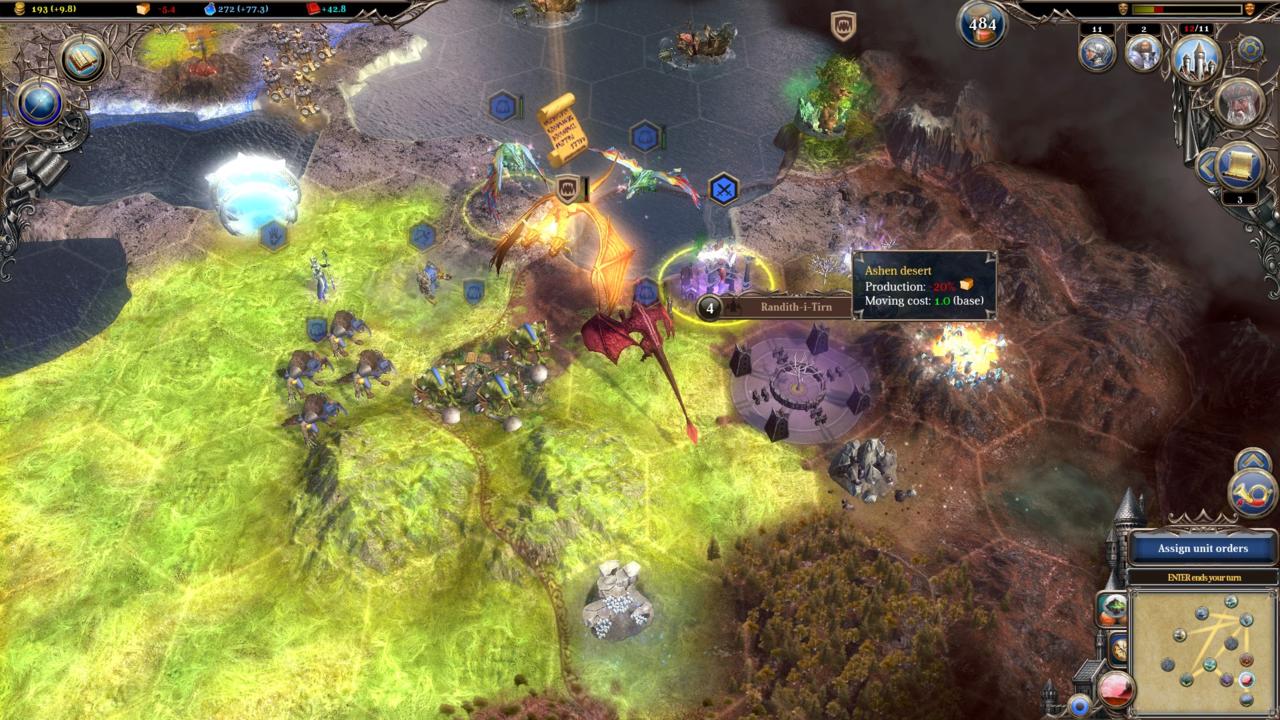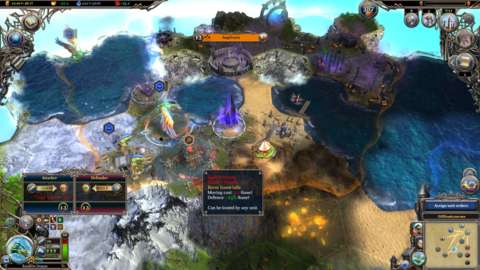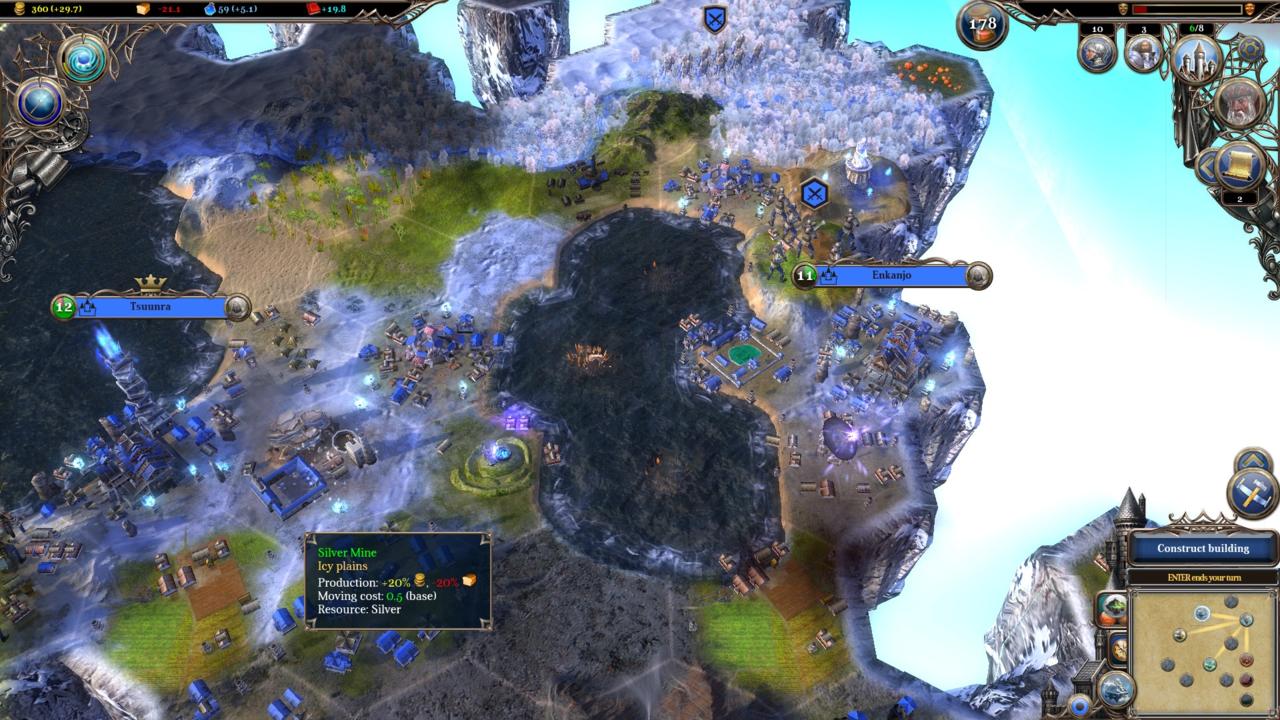It was sometime around the 13th straight hour of playing Warlock 2 that I realized I probably should have been asleep a few hundred turns ago. Despite that realization, I couldn't quit playing. Warlock 2 is a classic 4X strategy game that focuses a bit more on the combat and exploration side of things, and it works stunningly well for the most part. Warlock 2 starts with a novel premise--warfare split across multiple dimensions--and executes that vision with an inspired artistic flair, some unorthodox design choices, and a haunting, emergent narrative.
Before each match in Warlock, you pick your "great mage," a grand and nigh omnipotent leader to help guide your forces and vie for power with others of your kind. You research world-rending spells, gather your forces, and wage war on a transdimensional stage. Play, for the most part, revolves around slowly making your way across different planes of existence. These are radically different dimensions, with some being pits of demons and hellfire and others so imbued with the energy of life that simply being there heals your soldiers over time. Strange dimensions were a big feature in the first Warlock game as well, but this time around, they've moved from being an ancillary novelty to the focus of play.

The dimensions are linked by a haphazard network of portals. These act as choke points, much like Sins of a Solar Empire's phase lanes. Until the very late game, most of the strategy revolves around controlling as many of these portals as possible. As a given match progresses and your burgeoning empire begins to stretch across several of these planes, maintaining efficient troop movement and matching your empire's upkeep costs can become overwhelming. Around eight hours into my first match, I was struggling to maintain a decent flow of cash to support my armies. I was forced to take a hard look at each of my bases and nix the unnecessary ones. Simply destroying them can cause quite a bit of unrest in your citizenry; instead, you're encouraged to convert them to either massive forts or temples for your favored deity.
There are eight major gods you can follow, and each correlates with a broad class of forces: life vs. death, earth vs. wind, fire vs. water, and so on. Earning the attention of gods can be accomplished only by building temples and shrines in their honor, and doing so can give you access to some of the best spells in the game. In the main research path for spells, you only ever have two healing spells, and by the late game, those start losing their utility. I chose as my deity the god of life, and had quite a few options for keeping my troops in proper fighting condition. Toward the end of the game, my patronage had started to annoy some of the other gods, and I saw the living avatar of the god of death descend from the heavens to kill me. I didn't have the armies to repel him, and I was close enough to satisfying another victory condition that I just let him destroy some of my older bases. With that, though, I began to notice an underlying theme in Warlock 2--the idea of balance and order.

The first Warlock had you seeking to attain the highest power in the land. Following those events, one omnipotent being controls all of creation and has torn it apart to maintain his position as the United One, a title that's about as ironic as they come. After finishing my first campaign match, I saw a terse clip confirming my interpretation. Gods seek your favor, but should any one gain too much power over any other, they descend to correct the imbalance themselves. Everyone naturally seeks power and hopes to expand and conquer in this world, but after a point, that becomes problematic.
Powerful spells that can reshape vast swaths of land help buttress the central theme of the game, namely that as a great mage, you are one step removed from a god--a power that you probably shouldn't have. Each type of land has its own effects, and these move beyond the standard defense and movement bonuses. While I was invading the plane of death, I noticed that this unholy land was steadily killing my holy warriors. I steadily reworked the land and filled it with life-giving hills and flatlands. While it was nice to have that ability, it seemed fundamentally wrong. I was twisting and contorting the world to suit my own designs, but, as far as the basic setting goes, that's exactly how the world became so broken in the first place.
Sometimes the land-changing spells can be a bit too powerful, and it's far easier to destroy than it is to create. If an opponent simply scorches your plains to reduce farm output, your farms themselves aren't destroyed. They just become less efficient. If your farms or any other buildings are sunk entirely, however, you need a spell to fix the land and then rebuild all of your damaged structures. If another mage strikes the proper city with one of these spells, that can stall a military campaign or kill your ability to maintain units. The results are not too far removed from the role of nuclear weapons in other strategy games, but these spells can be cast very cheaply and cannot easily be blocked without constantly running counter spells. In multiplayer especially, it can often become a contest to see who forgets to block whom first, and that can get tedious quickly. Ostensibly, powerful spells are intended to be balanced by the fact that you can't cast where you can't see, but building up a small cadre of scouts to keep large chunks of the map visible at all times is hardly difficult.
Because the focus is on such small groups, distinctive visual design helps reinforce the idea that each piece of your army is special. Ships, lords, and even foot soldiers are remarkably well designed.
Even with a few scouts on hand, armies in Warlock are noticeably smaller than in most strategy games. At my strongest, I was fielding a force of maybe 20 units, and typically running about 10. With unit upgrades and the very limited movement speed of units, games focus more on managing small teams of powerful, well-trained soldiers than massive fodder armies. You also have the ability to keep up to four lords, which, depending on their level and upgrades, can easily overwhelm just about anything. That's for the best, because it avoids one of the biggest problems of games like Civilization. With the exception of the awkward pacing issues I mentioned earlier, games progress evenly and don't bog down with hundreds of soldiers in the late game. Managing their equipment and buffs is also much easier and more straightforward than it really should be given how many potential boosts you can give to any one unit.

Because the focus is on such small groups, distinctive visual design helps reinforce the idea that each piece of your army is special. Ships, lords, and even foot soldiers are remarkably well designed. Even with the basic troops, there's plenty of variety and flair to their visual presentation. Subtle graphical effects, such as the continually twisting rays of light that hover over holy, life-giving plains, make the overworld visually busy, but in such a way that helps the entire game feel more cohesive and solidly constructed. The user interface is similarly intricate, and all of these pieces work together to help sell this rendition of the standard fantasy setting.
That level of detail sometimes clashes with the lackluster execution of some of Warlock's better ideas. The potential for political interaction between the disparate factions is limited. With the exception of the undead's weakness to all things holy and life-giving, there's not a whole lot to make each faction feel distinct in terms of play. And when it's time to sit down at the negotiating table with other leaders, your choices can be summarized by "Give me stuff" and "I'll kill you."
Warlock was a creative game that tried a few interesting new things--namely the global spells and extra dimensional planes--and Warlock 2 takes them all a step further. Making the multiple dimensions a priority instead of a side bit refocuses play toward direct combat and exploration. The small army sizes prevent floods of units from taking and holding all points on the map and necessitate greater care with movement and empire expansion. Together, this creates a slow but focused style of play that's unlike anything else on the market.